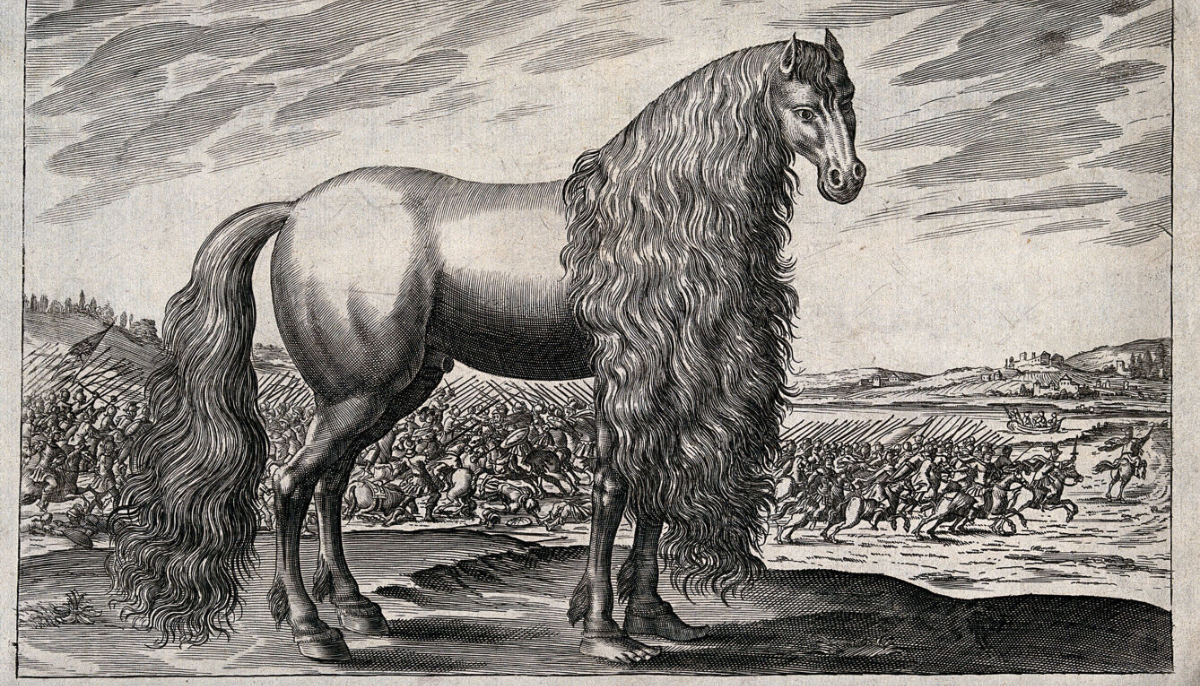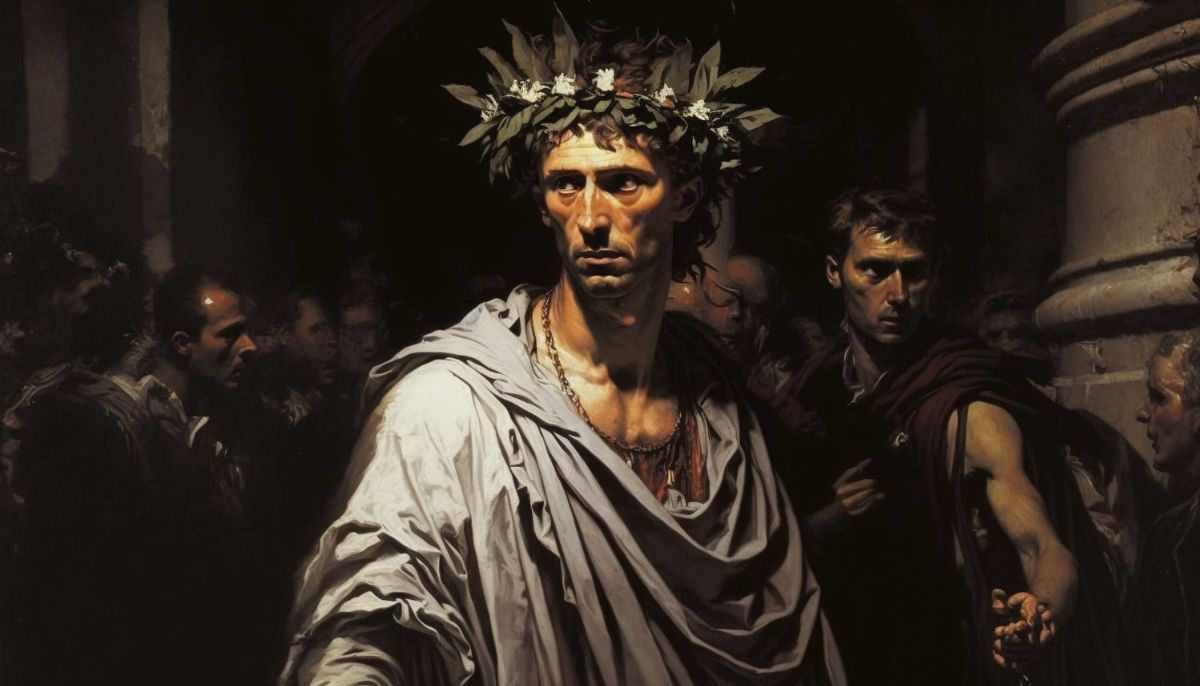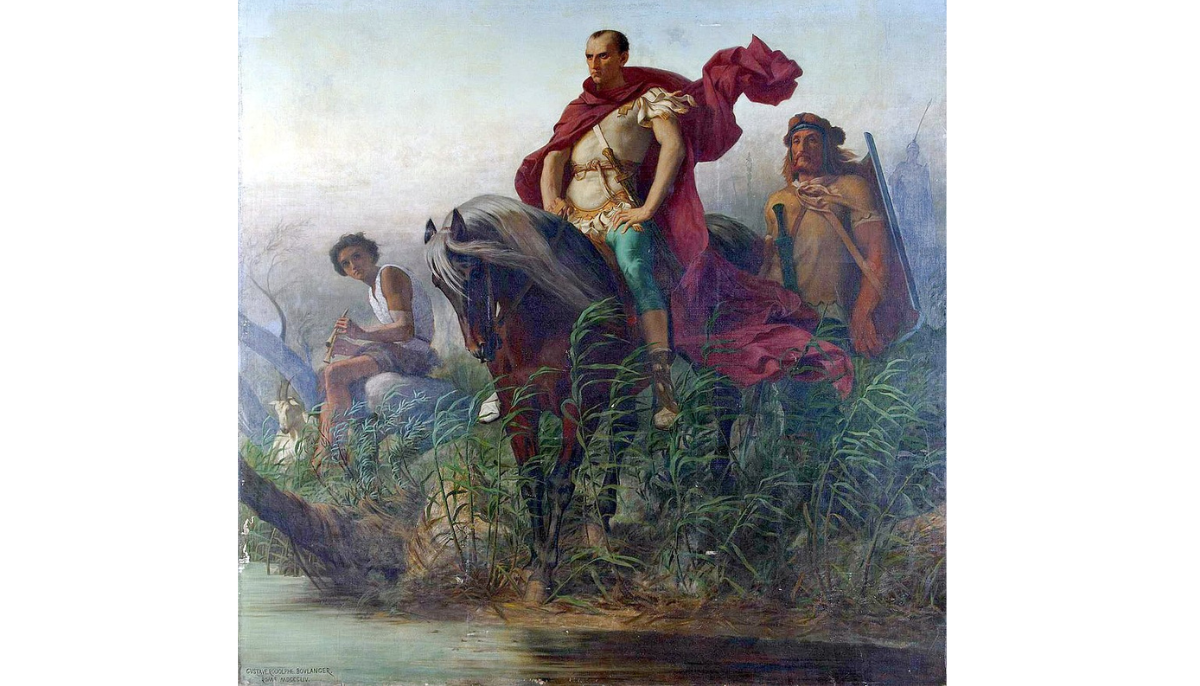“It is said, also, that Caesar, the Dictator, had a horse, which would allow no one to mount but himself, and that its forefeet were like those of a man.”
This article explores the legends surrounding Caesar’s horse, questions the authenticity of these tales, and delves into the symbolism of horses in Roman society, including Caesar’s iconic crossing of the Rubicon.
the stories of Julius Ceasar’s horse
Julius Caesar’s horse is much more than a historical figure’s mount. It’s an important part of Roman mythology. Renowned for its unique characteristic of only allowing Caesar himself to ride it, this horse was a symbol of Caesar’s power and destiny.
Caesar’s deliberate choice of this particular horse, possibly drawn to its extraordinary traits or sensing a more profound connection, further highlights its significance. Among its most intriguing and debated features is the claim that the horse had forefeet resembling human feet.
Adding to its legendary status is the horse’s role in a pivotal moment in Roman history – Caesar’s crossing of the Rubicon. The decision to ride this specific horse during such a critical event underscores its importance in both Caesar’s life and Roman lore.
The horse’s significance extended beyond its life; after its death, Caesar commissioned a statue in its honor, an uncommon practice for animals in Roman times, signifying the profound respect and value Caesar placed on his horse.
Did Julius Caesar’s horse have human feet?

The legendary horse of Julius Caesar could have been affected by a real, albeit rare, physiological condition. Noted by Pliny the Elder in his “Natural History,” this detail about the horse’s forefeet resembling those of a human has sparked much debate.
One plausible explanation is the possibility of a deformity, specifically polydactyly, in the horse’s hooves. While uncommon, such deformities occur in horses, and the hooves of Caesar’s horse might have been slightly notched at the edges, a feature possibly exaggerated by a sculptor to resemble human fingers.
In ancient times, unusual physical traits in animals were often seen as omens or signs from the gods. Caesar’s choice of a horse with such a distinct characteristic could have been influenced by the belief that this deformity signified something extraordinary or auspicious, aligning with his image as a powerful and favored leader.
A Mythical Embellishment by Pliny?
Conversely, the story of Caesar’s horse having human-like feet might be an apocryphal tale, a product of the fantastical elements prevalent in Pliny’s writings. Pliny’s “Natural History” is known for its mixture of factual observations and mythical accounts, making it a challenging source for confirming historical details.
This perspective aligns with the view of some scholars who caution against taking Pliny’s accounts too literally, given the inclusion of various fantastical creatures and phenomena in his work.
The depiction of Caesar’s horse with human-like feet likely represents a mythical exaggeration rather than a factual account. In this light, the tale becomes more about the storytelling culture of the era and less about an actual historical occurrence.
The narrative around Caesar’s horse, then, might be seen as an imaginative embellishment designed to augment the legend of Caesar himself rather than a literal description of the animal’s physical characteristics.
The Historical and Symbolic Significance of Caesar’s Horse

For Julius Caesar, being seen on a horse was a strategic display of authority and martial prowess. In a culture that equated horseback riding with military competence and leadership, Caesar’s choice to be frequently seen on his horse was a powerful statement. It conveyed his readiness for battle, his alignment with Roman ideals of strength and courage, and his position as a leader of men.
Additionally, riding a horse, especially one as unique as his, distinguished him from the common soldier and civilian, elevating his status and reinforcing his image as a formidable and distinguished leader.
how Caesar used his horse as a symbol of power and leadership
In ancient Rome, symbols were crucial in conveying power, status, and authority. Leaders frequently employed emblematic imagery, with animals like horses particularly representing strength, control, and nobility.
Caesar’s use of symbols extended beyond his horse. He skillfully utilized his awarded civic crown and laurel wreath as potent political tools. In a society that deeply valued such symbols, Caesar’s strategic use of them played a pivotal role in crafting his public persona and reinforcing his position as a formidable leader in Roman history.
Julius Caesar’s horse was a potent symbol of his power and leadership. Choosing a horse with such unique features was a calculated decision to enhance his image as an exceptional leader. This exclusivity between the horse and Caesar created an aura of chosenness or divine favor, reinforcing his authority and distinctiveness as a leader.
Caesar’s Involvement in Critical Battles
Caesar did not shy away from direct involvement in battle, especially in critical situations. At pivotal moments, such as the battle of Munda, when the odds of victory seemed uncertain, Caesar took a hands-on approach.
He was known to personally enter the fray, a move that not only demonstrated his courage but also served as a strategic tool to inspire his troops.
Crossing the Rubicon on Horseback

One of the most defining moments in Roman history, Caesar’s crossing of the Rubicon, was also where his horse played a significant role.
Riding into what would become a civil war, the image of Caesar on his horse at the Rubicon was emblematic of his boldness and determination. It was a deliberate display of defiance and authority, cementing his reputation as a decisive and fearless leader.
The act of crossing the Rubicon on his horse signified a point of no return, not just for Caesar but for Rome itself, and the horse became a part of this historic moment.
the statue of caesars horse
Following the death of his horse, Caesar chose to honor it with a statue, a gesture that underscored the animal’s deep symbolic significance in his life and legacy. This act of commemoration went beyond merely paying tribute to a favored steed; it was an acknowledgment of the horse’s central role in the narrative of Caesar’s life.
Placed before the temple of Venus Genetrix, the statue served as a lasting reminder of the bond between Caesar and his horse and of the horse’s symbolic representation of his power and unique status.
In a society where such honors were usually reserved for deities or eminent figures, the statue of the horse underscored its extraordinary place in both Caesar’s life and in the cultural and historical imagination of Rome.






